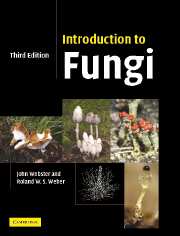Book contents
- Frontmatter
- Contents
- Preface to the first edition
- Preface to the second edition
- Preface to the third edition
- Acknowledgements
- 1 Introduction
- 2 Protozoa: Myxomycota (slime moulds)
- 3 Protozoa: Plasmodiophoromycota
- 4 Straminipila: minor fungal phyla
- 5 Straminipila: Oomycota
- 6 Chytridiomycota
- 7 Zygomycota
- 8 Ascomycota (ascomycetes)
- 9 Archiascomycetes
- 10 Hemiascomycetes
- 11 Plectomycetes
- 12 Hymenoascomycetes: Pyrenomycetes
- 13 Hymenoascomycetes: Erysiphales
- 14 Hymenoascomycetes: Pezizales (operculate discomycetes)
- 15 Hymenoascomycetes: Helotiales (inoperculate discomycetes)
- 16 Lichenized fungi (chiefly Hymenoascomycetes: Lecanorales)
- 17 Loculoascomycetes
- 18 Basidiomycota
- 19 Homobasidiomycetes
- 20 Homobasidiomycetes: gasteromycetes
- 21 Heterobasidiomycetes
- 22 Urediniomycetes: Uredinales (rust fungi)
- 23 Ustilaginomycetes: smut fungi and their allies
- 24 Basidiomycete yeasts
- 25 Anamorphic fungi (nematophagous and aquatic forms)
- References
- Index
- Plate section
4 - Straminipila: minor fungal phyla
- Frontmatter
- Contents
- Preface to the first edition
- Preface to the second edition
- Preface to the third edition
- Acknowledgements
- 1 Introduction
- 2 Protozoa: Myxomycota (slime moulds)
- 3 Protozoa: Plasmodiophoromycota
- 4 Straminipila: minor fungal phyla
- 5 Straminipila: Oomycota
- 6 Chytridiomycota
- 7 Zygomycota
- 8 Ascomycota (ascomycetes)
- 9 Archiascomycetes
- 10 Hemiascomycetes
- 11 Plectomycetes
- 12 Hymenoascomycetes: Pyrenomycetes
- 13 Hymenoascomycetes: Erysiphales
- 14 Hymenoascomycetes: Pezizales (operculate discomycetes)
- 15 Hymenoascomycetes: Helotiales (inoperculate discomycetes)
- 16 Lichenized fungi (chiefly Hymenoascomycetes: Lecanorales)
- 17 Loculoascomycetes
- 18 Basidiomycota
- 19 Homobasidiomycetes
- 20 Homobasidiomycetes: gasteromycetes
- 21 Heterobasidiomycetes
- 22 Urediniomycetes: Uredinales (rust fungi)
- 23 Ustilaginomycetes: smut fungi and their allies
- 24 Basidiomycete yeasts
- 25 Anamorphic fungi (nematophagous and aquatic forms)
- References
- Index
- Plate section
Summary
Introduction
The kingdom Chromista was erected by Cavalier-Smith (1981, 1986) to accommodate eukaryotic organisms which are distinguishable from the Protozoa by a combination of characters. Some of these are concerned with details of photosynthesis, such as the enclosure of chloroplasts in sheets of endoplasmic reticulum, and the absence of chlorophyll b, the latter feature being used for the naming of the kingdom. Other defining characters apply also to the non-photosynthetic members of the Chromista (Kirk et al., 2001). These are as follows:
1. The structural cell wall polymer is cellulose, in contrast to walls of Eumycota which contain chitin.
2. The inner mitochondrial membrane is folded into tubular cristae (Fig. 4.1a) which are also found in plants. In contrast, mitochondrial cristae are generally lamellate in the kingdoms Eumycota (Fig. 4.1b) and Animalia.
3. Golgi stacks (dictyosomes) are present; these are also found in the Protozoa (see p. 64). In contrast, in the Eumycota the Golgi apparatus is usually reduced to single cisternae (see Figs. 1.3, 1.10).
4. Flagella are usually present during particular stages of the life cycle; they always include one straminipilous flagellum (Lat. stramen = straw, pilus = hair). Dick (2001a) considered this feature to be of such high phylogenetic significance that he has renamed the kingdom Chromista as Straminipila. The straminipilous flagellum is discussed in detail in the following section.
5. The amino acid lysine is synthesized via the α,ε-diaminopimelic acid (DAP) pathway.
- Type
- Chapter
- Information
- Introduction to Fungi , pp. 67 - 74Publisher: Cambridge University PressPrint publication year: 2007



